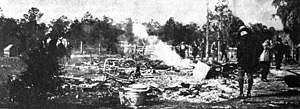The remains of Sarah Carrier's house where two blacks and two whites were killed in Rosewood in January 1923
The Rosewood massacre was a violent, racially motivated conflict that took place during the first week of January 1923 in rural Levy County, Florida, United States. At least six blacks and two whites were killed, and the town of Rosewood was abandoned and destroyed in what contemporary news reports characterized as a race riot. Racial disturbances were common during the early 20th century in the United States, reflecting the nation's rapid social changes. Florida had an especially high number of lynchings in the years before the massacre, including the well-publicized Perry race riot where a black man had been burned at the stake in December 1922.
Rosewood was a quiet, primarily black, self-sufficient whistle stop on the Seaboard Air Line Railway. Spurred by unsupported accusations that a white woman in nearby Sumner had been beaten and possibly raped by a black drifter, white men from nearby towns lynched a Rosewood resident. When black citizens defended themselves against further attack, several hundred whites combed the countryside hunting for black people, and burned almost every structure in Rosewood. Survivors hid for several days in nearby swamps and were evacuated by train and car to larger towns. Although state and local authorities were aware of the violence, they made no arrests for the activities in Rosewood. The town was abandoned by black residents during the attacks. None ever returned.
Although the rioting was widely reported around the country, few official records documented the event. Survivors, their descendants, and the perpetrators remained silent about Rosewood for decades. Sixty years after the rioting, the story of Rosewood was revived in major media when several journalists covered it in the early 1980s. Survivors and their descendants organized to sue the state for having failed to protect them. In 1993, the Florida Legislature commissioned a report on the events. As a result of the findings, Florida became the first U.S. state to compensate survivors and their descendants for damages incurred because of racial violence. The massacre was the subject of a 1997 film directed by John Singleton. In 2004, the state designated the site of Rosewood as a Florida Heritage Landmark.




0 comments:
Post a Comment